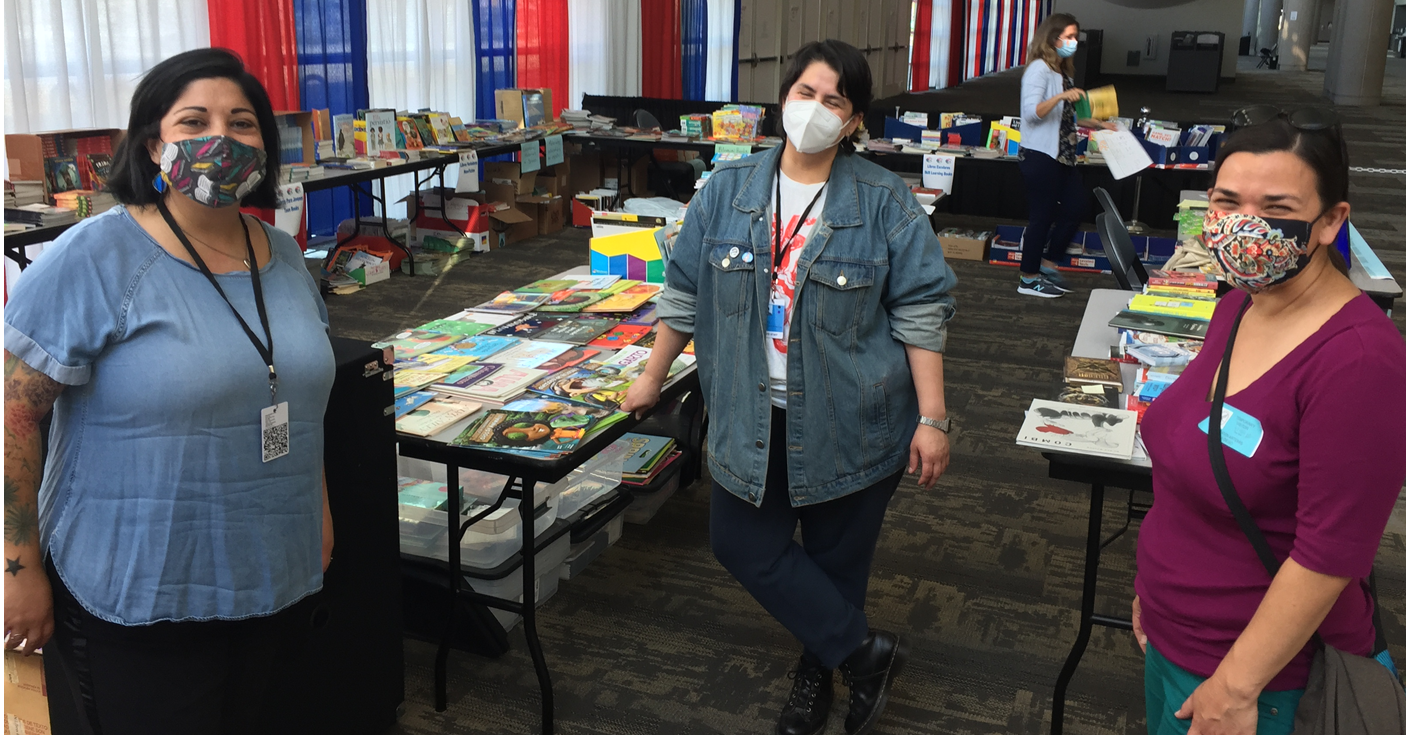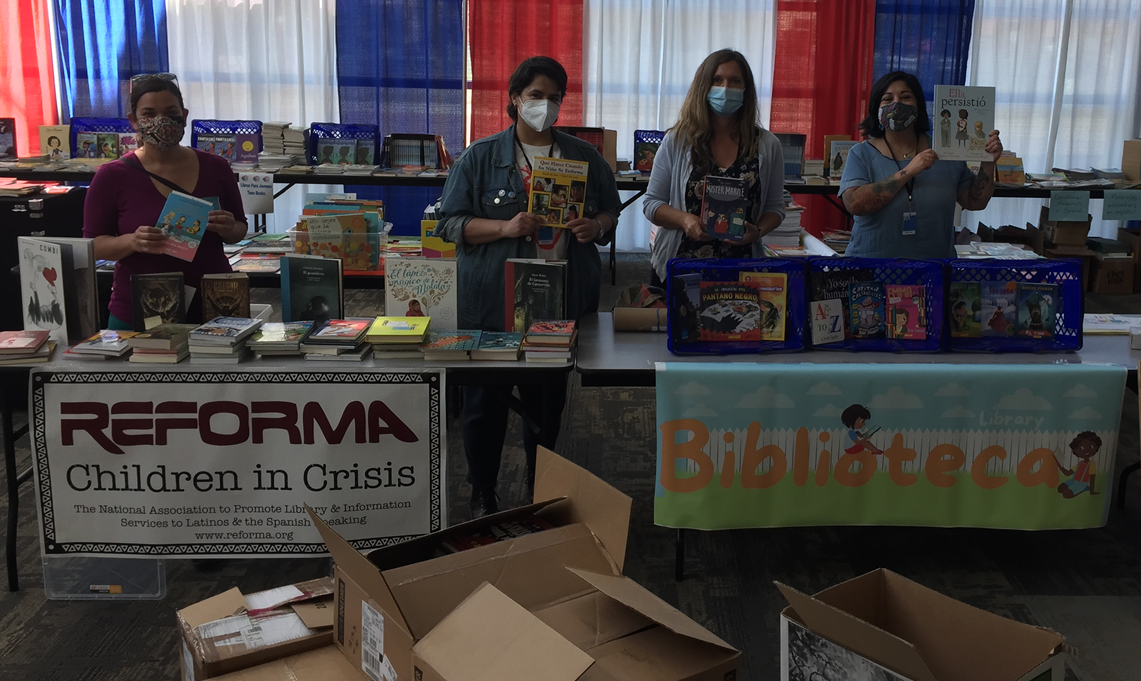REFORMA and volunteer librarians are working to create libraries and do story times for the young people crossing the border.
When Ady Huertas looked up at the end of her story time, she was concerned. Teens with pillows and blankets lay in front of her sleeping on the floor of the San Diego Convention Center (SDCC), where she was reading to youth being housed in a shelter for unaccompanied minors who had crossed the southern border into the United States.
“I thought I put them to sleep, they were so bored,” says Huertas, who is the supervising librarian of youth and family services at San Diego Public Library. She began volunteering at the shelter—which opened to refugee children in March—after helping coordinate a book donation through her work with
REFORMA Children in Crisis (CIC) project.
 |
At San Diego Convention Center. L-R: Ady Huertas, San Diego Public Library; Itza Villaboy, SD City College and President of LIBROS Chapter of REFORMA;and Cristela Garcia-Spitz, University of California, San Diego.
Photo courtesy of REFORMA
|
|
Huertas, who has been working with CIC since 2014, connected with Kristin Shea, reading program director of the Children’s Initiative at AARP Experience Corps San Diego, who is coordinating the library at the shelter. After being vetted, Huertas began volunteering three days a week in April at the SDCC, which is one of many such emergency intake centers opening around the country to handle the surge in unaccompanied minors. Most are located near the border in Texas and Southern California.
At first, Huertas helped organize the library, setting up tables for the hundreds of donated books. CIC’s mission is to bring books to kids who cross the border. CIC helps get books to the children in shelters or into backpacks that it provides when the children are headed to their destinations.
The program has also helped create libraries at shelters and, before the pandemic, it coordinated group visits to libraries near the shelters to teach the children how the public library can be a resource for them in America.
At the SDCC during that first story time, Huertas had encouraged the group to bring their pillows and blankets so the hard floor would be more comfortable. She didn’t anticipate her reading would put them to sleep. To her, that was not a sign of success. But the next day, she received a text saying that the staff and kids really enjoyed the story time and would like to do more. With the help of two other volunteer librarians from the area, the shelter now tries to have read-aloud time for different groups of kids every day.
“We’re just getting started,” says Huertas, who reads about six books during each two-hour session. She does it all in Spanish and mixes picture books and chapter books such as Charlotte’s Web. She has found success with wordless books, too, as she and her young listeners can add to the story.
The SDCC takes in mostly teenage girls, who will stay until workers can connect them with family or sponsors in the United States. The site can house nearly 1,500 children ages 5 to 17, and the huge numbers are just one of the differences between now and 2014, when the original influx of unaccompanied minors led REFORMA to create CIC.
While the number of children entering the U.S. has fluctuated over the years, the last few months has brought the largest number of unaccompanied minors that CIC cochair Patrick Sullivan can remember. New shelters are popping up across the country and housing hundreds, if not more than 1,000 children.
Sullivan recently alerted REFORMA chapters about new emergency intake centers in California, Texas, Michigan, and Pennsylvania. He asked chapter members to learn about the locations, organizations working there, and what they might need to assist with what his email called the “staggering number” of unaccompanied minors going through the system.
 |
Kristin Shea (second from the right), reading program coordinator for The Children's Initiative, AARP Experience Corps San Diego. Shea is coordinating the library at the SDCC shelter. Here with volunteers (from left) Garcia-Spitz, Villaboy, and Huertas.
Photo: Courtesy of REFORMA
|
Sullivan asked chapter members to alert CIC if they see a new shelter coming to their area or try “to put together your own local group there to help.” He adds, “Just making people aware of it through social media, phone calls, or emails—it makes a world of difference.”
Under the Biden administration, Sullivan sees more nonprofit organizations working together at these locations to help the kids and a generally more positive feeling as workers process the migrant children as quickly as possible to a final destination.
“It’s much more intense,” says Sullivan, but he is bolstered by a more coordinated approach and greater willingness to accept help. Under the Trump administration, gaining access to a shelter or making donations could be difficult. While no one can just walk right in now, it is no longer a fight to gain access and get books to the kids. Volunteers are welcome and needed.
“There are a number of opportunities for librarians to get involved,” says Sullivan. “Librarians can do story times or help with library organization, ordering books, or setting up wish lists.”
When REFORMA makes donations, the organization makes clear that if a young person in the shelter wants to keep a book, they can. Shelter staff can contact the organization to have that title replaced.
Librarians looking to help will be best served by doing a little research first, says Sullivan. Find the nearest shelter and learn what nonprofit organizations are working there to reach out to them, advises Sullivan. They should also check for a
local REFORMA chapter that may already be assisting.
CIC is dedicated to getting books not only to the kids who have crossed the border but also to those remaining in Mexican border towns such as Tijuana and Matamoros. There, families and unaccompanied children remain in makeshift housing and schools as they were left in limbo by American government policies and, in some cases, complications of the pandemic.
REFORMA receives donations from publishers as well as individuals. Monetary donations are used to purchase and ship books, but the website also has recommended booklists for individuals who want to buy books or start a book drive.
Most of the titles REFORMA donates are in Spanish or bilingual, but many shelters request books in English, too, to help young migrants learn the language. For instance, Sullivan says, they might ask for Sandra Cisneros’s The House on Mango Street, along with La Casa en Mango Street.
Sullivan brought books to the SDCC and was impressed with the organization and size of the efforts. While he didn’t interact with any of the youth there, through the years, he has often seen the impact books can have on kids.
As a volunteer with Jewish Family Services, he took families from a shelter to the airport and assisted them with the ticketing and TSA process. He remembers watching a 4-year-old girl after giving her a book. She seemed immune to all that was going on around her when she had that book in her hands, he says.
“She’s sitting in the TSA line, on the floor, and it just takes her away,” says Sullivan. “They go to a different place.”








Add Comment :-
Be the first reader to comment.
Comment Policy:
Comment should not be empty !!!